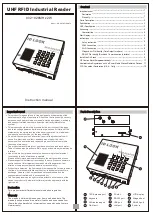
154
CompuScope 3200C
EXTERNAL CLOCK
The CompuScope 3200C allows the use of either internal or external clocks. External clock can be very useful
in systems which require synchronous data capture. These applications include A/D Testing,
Telecommunication, DSP Systems, Video, Ultrasonic Imaging, etc.
The external clock is carried on the 68 wire input connector. A high-speed comparator converts the input level
of the clock to CMOS/TTL levels used by the on-board data latching and de-multiplexing circuitry.
The maximum clock frequency of the input clock is 100 MHz. The driving circuitry on the user’s circuit must be
capable of driving a 50
Ω
load.
CLOCK EDGE SELECTION
The user is allowed to select either the rising or falling edge of the input clock to latch the data.
This flexibility allows the user to apply the CompuScope 3200C in situations in which one of the clock edges
and input data do not satisfy the timing requirements. In such cases, using the opposite edge of the clock may
resolve the timing conflict.
CLOCK AND DATA TIMING
If the customer operates the CompuScope 3200C with an external clock, it should be kept in mind that the
maximum speed of the input clock is 100 MHz with a rise and fall time of 2.5 ns or less. The minimum clock
frequency is zero, i.e. the clocks can be started and stopped at will, once the acquisition has started.
The setup and hold times of the data with respect to the active edge of the clock must satisfy the minimum
requirements listed in the specifications.
CRYSTAL-BASED TIMEBASE
The CompuScope 3200C allows the use of both Internal or External clocking under software control.
When the internal clock is selected, the sampling clock is provided by a crystal-controlled oscillator, thereby
providing very good short and long term timing accuracy.
When an external clock is used, the timing accuracy depends entirely on the quality of the external clock
supplied by the user.
INPUT CONNECTOR
The data is input to the CompuScope 3200C over a 68 wire Pleated Foil cable. The input connector is a 68 pin
MDR socket (P/N 3M 10268-55H3VC). The mating connector is a 3M 10168-6000EC. The mating connector
hood is a 3M 10368-A230-00.
Each CompuScope 3200C card is supplied with a 6 foot
Pleated Foil
cable featuring the 3M 10168-6000EC
connector.
TRIGGER
An External Trigger input is provided on the CompuScope 3200C. The configuration of this input is set at the
factory as either differential ECL/PECL or single-ended CMOS/TTL.
It is possible to trigger either on the rising or falling edge of this trigger input.
TRIGGER OUTPUT
A Trigger Output signal (5 Volt TTL) is also provided by the CompuScope 3200C. This signal is synchronized
to the internal clock which runs the de-multiplexed memory counters. As such, there can be a latency of as much
as 8 clock cycles between a trigger input and a trigger output.
This Trigger Output can be used to synchronize an entire system to Gage’s internal clock.
BNC BREAKOUT BOARD
One of the popular accessories for the CompuScope 3200C is a
BNC Breakout Board
which connects to the card
using the pleated foil cable and allows the user to inject digital data, clock and trigger signals using BNC coaxial
connectors.
Summary of Contents for CompuScope 14100C
Page 6: ......
Page 24: ...18 Installing CompactPCI PXI Master Slave multi card systems Notes ...
Page 30: ...24 Memory organization on CompuScopes except for CS85GC Notes ...
Page 75: ...Driver installation guide 69 Help About CsTest ...
Page 76: ...70 Driver installation guide Notes ...
Page 90: ...84 CompuScope 85GC Notes ...
Page 174: ...168 Notes Notes ...















































